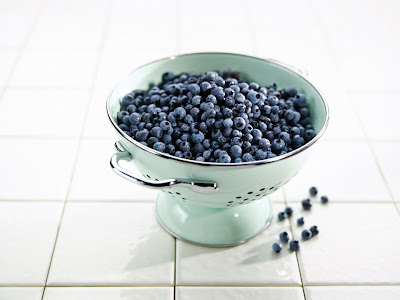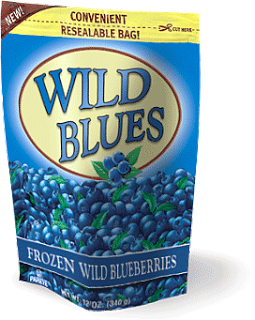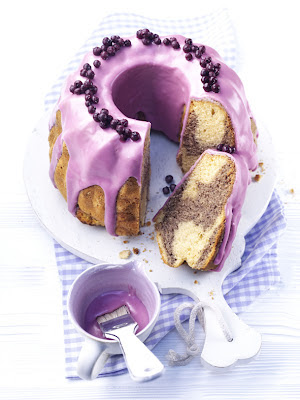FAQ Blue
The 10 Most Popular Questions About Cooking with Frozen Wild Blueberries – Answered!
More than ever, wild blueberries are smothering breakfast, lunch and dinner plates, and they are doing it in a variety of unprecedented ways. Today, consumers are taking full advantage of this delicious, high-antioxidant fruit.
Why? The wild blueberry’s role in preserving brain health, preventing some types of cancers, and battling inflammation caused by free radicals is no longer the secret of researchers and scientists. Wild blueberries are the domain of everyone from nutritionists and chefs to home cooks and time-starved moms.

Wild blueberries share space at the very top of most any list of the healthiest foods – rivaling omega-3 rich fish and leafy greens – as nutrition’s most superb delivery system. It’s made the “at least one serving per day” rule of wild blueberries gospel in kitchens across the globe. Thousands of recipes showcase their versatility and their knack for making a simple plate soar with taste.
Whether you are new to cooking with frozen or you’ve known about this IQF ingredient for years, you’ll benefit from knowing the ins and outs of how to best use your blues. We’ve compiled the most popular questions about using frozen wild blueberries in your kitchen so you are getting the very best out of one of the natural world’s most superior foods. Here are our ten most frequently asked questions about cooking with blue, including how to make the perfect pancake and debunking the myth of blue batter.
1. Do frozen wild blueberries work in a recipe that calls for fresh?
Yes. Frozen wilds are ideal for recipes in just about every instance. Allison Fishman, author of You Can Trust a Skinny Cook, says using frozen is her ideal method for cooking, mostly because “it’s they best way to get the whole berry.” She also likes the cost savings of frozen, and uses frozen wild blueberries in all of her recipes that call for blueberries, with the rare exception of those used to garnish lemon tarts, where she opts for fresh. The IQF method makes making the case for frozen easy—they are a seamless substitution for recipes, jams, toppings, and for eating blueberries all by themselves.
2. Can I substitute wild for the larger cultivated berry?
 Absolutely. In fact, for reasons of nutritional impact and flavor, it’s always advisable to substitute cultivated blueberries with wild. Cultivated blueberries come fresh and frozen, so look for the moniker “wild” whenever you purchase – they are a product exclusively of Maine or Nova Scotia. Wild will provide you with more powerful nutrition, thanks to the higher skin-to-pulp ratio and the environmental “stressors” that allow wild blueberries to develop a protection that translates into powerful nutrients and more intense flavor than their cultivated cousins. It’s also important to keep in mind that wild blueberries, due to their wild nature, naturally contain a variety of berries, which accounts for the variations in size, color and taste.
Absolutely. In fact, for reasons of nutritional impact and flavor, it’s always advisable to substitute cultivated blueberries with wild. Cultivated blueberries come fresh and frozen, so look for the moniker “wild” whenever you purchase – they are a product exclusively of Maine or Nova Scotia. Wild will provide you with more powerful nutrition, thanks to the higher skin-to-pulp ratio and the environmental “stressors” that allow wild blueberries to develop a protection that translates into powerful nutrients and more intense flavor than their cultivated cousins. It’s also important to keep in mind that wild blueberries, due to their wild nature, naturally contain a variety of berries, which accounts for the variations in size, color and taste.
3. Can I substitute blueberries for other fruits in recipes?
As in this recipe from Tastebook.com, blueberries are a straightforward substitute in most recipes. When fruit is the key ingredient, consider using a mixture of wild blueberries and another fruit. It can create a wonderful flavor combination. And, the wild flavor is one that many find preferable to other berries; they provide a delicious burst of flavor ranging from sweet to tangy, thanks to their natural variations. It’s a taste you just can’t duplicate it with other berry ingredients.
4. What’s the best way to cook with frozen wild blueberries? Should they be thawed?
Frozen blueberries do not need to be thawed before you add them to cake or muffin batter, for instance. They can and should be left in their frozen state for most baking unless the recipe calls for them to be defrosted. Keeping them in their frozen state will preserve their texture and individuality and will keep the blueberries from bleeding into the recipe.
Fresh frozen blues usually come without additives or syrups, making them a seamless substitution. However, if you find your frozen blueberries give off a little more juice than fresh berries, it might be necessary to reduce the liquid and increase the thickener when you use them in desserts such as pies, tarts or cobblers.
5. Is frozen as good as fresh?
 Yes. The IQF method freezes wild blueberries at their peak of taste and nutrition. Today, we’re lucky that this modern freezing technique means there is no compromising when it comes to nutrition (they can remain frozen for over two years without losing their flavor or nutritional value). It also means they are economical and accessible any season and any day of the week for spontaneous recipes and meal improvising.
Yes. The IQF method freezes wild blueberries at their peak of taste and nutrition. Today, we’re lucky that this modern freezing technique means there is no compromising when it comes to nutrition (they can remain frozen for over two years without losing their flavor or nutritional value). It also means they are economical and accessible any season and any day of the week for spontaneous recipes and meal improvising.
6. How do I declump frozen berries?
In fact, the days of clumped fruit and vegetables are virtually over. With little exception, today’s frozen wild blueberries available in the frozen food aisle use the IQF method of freezing. That means they are “individually quick frozen” which preserves their individuality when they are frozen and when they are thawed.
7. What’s the best way to use frozen wild blueberries in pancakes?
When using frozen wild blueberries in pancakes, eHow.com suggests adding them to each pancake as it cooks. The berries will sink into the batter and will be hot and juicy after the pancake is turned and cooking is completed. Avoid adding frozen berries directly to the batter – that goes for fresh or frozen – most chefs prefer their pancake additions to assemble in the middle of each cake. Sprinkle enough for each pancake on the batter-up side before flipping for the ideal pancake aesthetic.
8. How can I use wild blueberries for more than just dessert and breakfast?
It’s a great question, and one consumers are asking more and more as they discover that integrating blueberries into more recipes can enhance health benefits and give dishes a unique flavor profile.
There are plenty of resources for cooking with blueberries (that don’t have to do with pancakes or muffins) online and in cookbooks devoted solely to the fruit. Blueberries are a popular addition to many salads, for use in chutney, and in glazes and sauces that make delicious additions to pork and fish dishes. Wild blueberries also provide the basis of oodles of unique appetizers such as spicy tortillas or dishes like this Savory Blueberry Ricotta Pizza.
Tip: The sweet and tangy taste of wild blueberries provides an ideal contrast to dishes featuring duck or pork, as in this recipe for Pork Chops with Blueberry Ginger Relish from EatingWell.com. The burst of flavor makes protein dishes memorable—it’s why they are so popular with chefs.
9. How can I prevent my batter from turning blue when I use wild blues?
“Personally, I think frozen blueberries are good for purées and smoothies and not much else.”
 Statements like this are troubling—it means some of us are missing out on convenient, healthy additions to our cooking repertoire. It’s not necessary to be stuck in the smoothie rut because of the “swirl” factor – today’s IQF blueberries are much more versatile then many people realize. While it’s true that a blue swirl can interfere in some recipes where the batter must remain pristine, there’s no need to wait for August to buy fresh to bake with blue. Just follow these easy steps instead:
Statements like this are troubling—it means some of us are missing out on convenient, healthy additions to our cooking repertoire. It’s not necessary to be stuck in the smoothie rut because of the “swirl” factor – today’s IQF blueberries are much more versatile then many people realize. While it’s true that a blue swirl can interfere in some recipes where the batter must remain pristine, there’s no need to wait for August to buy fresh to bake with blue. Just follow these easy steps instead:
Freeze & Fold: First, wild blueberries create the blue color when they defrost or burst, so be sure to keep them fully frozen and unmangled. Then, make sure not to add your blues too early. Adding blueberries to a cake or muffin recipe should be done last. They should be folded in and baked immediately to prevent bleed. Tip: Toss your blueberries in a touch of flour to provide additional insurance against the blue swirl.
Mind the pH: According to the Blueberry Council, if your muffin, cake or pancake batter is too “basic”, that is, it has a high pH, it can lead to a batter’s colored haze. Blueberries turn reddish when exposed to acids, such as lemon juice and vinegar, and greenish-blue in a batter that has too much baking soda, which creates an alkaline environment. The rule of thumb for preserving the beauty of blues: adjust the acidity of your batter by replacing some of the liquid with buttermilk, sour cream, applesauce or citrus juice and reducing baking soda/powder.
Embrace the Swirl: As shown in this cheesecake recipe, which takes advantage of the blueberry’s ability to create an eddy of purple-blue color, it can sometimes be a boon to embrace the swirl. It can also work to your advantage in things like eggnog, yogurt servings, or any dessert with a monotonous white topping. Use berries sparingly on toppings to create the perfect blue twist. Take a look at how Sassandveracity.com makes use of color with these Not Quite Blue Cupcakes with Not Quite Red Ice Cream. Way to embrace the swirl!
10. How do I keep wild blueberries from “dropping”?
One reason blueberries sink is because the specific gravity may be too low, says the Blueberry Council. Increase specific gravity by using a thicker, denser batter. Dropping can also be the result of too much air in the batter: avoid over-blending during the first stage of creaming.

Bonus FAQ: Basic Measurements & Conversions for Wild Blueberries:
- 1 pint of fresh blueberries weights about 3/4 of a pound or 2 cups
- 1 10-ounce package of frozen blueberries = 1-1/2 cups
- 1 quart = 1-1/2 pounds or 4 cups
- Cultivated and wild are 1:1, but your count of wild will be higher due to their compact size. (That’s more skin per cup and more antioxidant power!)
- Frozen and fresh are also 1:1; allow for a bit of moisture for frozen by pulling back on a liquid ingredient by a 10%.
Pickyourown.org offers these helpful recipe rules of thumb:
- It takes about 4 cups of blueberries to make a blueberry pie. They make their point with this classic deep dish blueberry pie recipe.
- A normal batch of blueberry preserves, jam or jelly requires 5 pints of berries. Here’s the recipe in 12 Simple Steps.
Q: Can you really use frozen for jams?
A: You can. Most frozen wild products are pure wild blueberries with no syrup, making it a seamless substitution. Find this and other tips for frozen substitutions at eHow.com.

